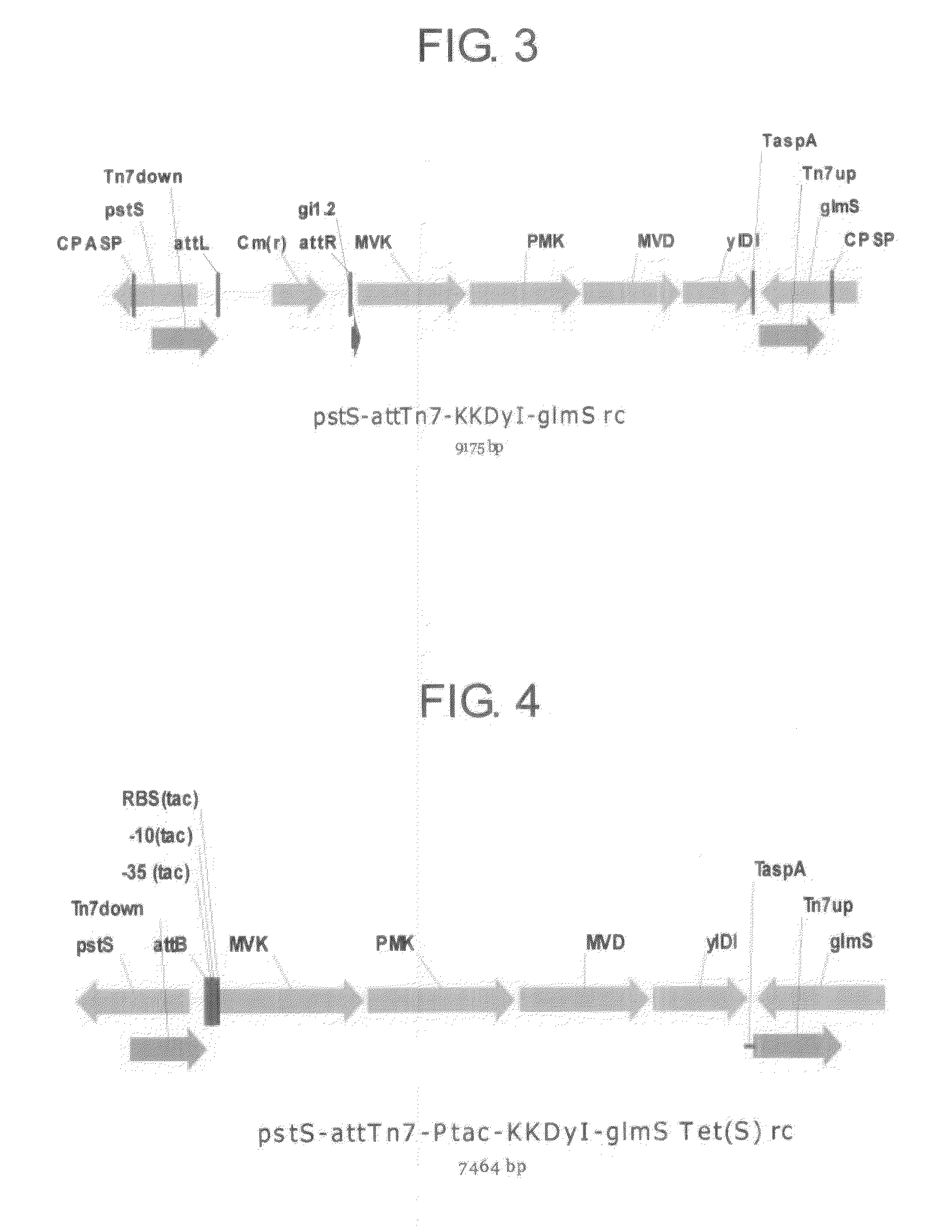Isoprene synthase and gene encoding the same, and method for producing isoprene monomer
a technology of isoprene and synthase, which is applied in the direction of carbon-oxygen lyase, lyase, peptide, etc., can solve the problems of difficult to increase agricultural production, increase in natural rubber yield is hardly expected, and the balance of demand and supply is predicted to become tight, and achieves excellent isoprene monomer production system
- Summary
- Abstract
- Description
- Claims
- Application Information
AI Technical Summary
Benefits of technology
Problems solved by technology
Method used
Image
Examples
example 1
Evaluation of Ability to Produce Isoprene in Plants
1-1) Measurement of Amount of Isoprene Formed Per Unit Weight of Dry Leaves
[0145]First, an amount of isoprene formed per 1 g of dry leaves in the plant was measured for evaluating an ability to produce isoprene in plants. Mucuna (Mucuna bracteata), Weeping willow (Salix babylonica), American sweetgum (Liquidambar styraciflua), Myrtle (Myrtus communis), and Kudzu (Pueraria lobata) were used as the plants.
[0146]In the measurement of an amount of formed isoprene, a gas replaceable desiccator (trade name: Vacuum Desiccator, manufactured by AS ONE Corporation) was housed in an incubator (trade name: Growth Chamber MLR-351H, manufactured by SANYO), and the incubator was set to a high temperature induction condition (an illuminance of 100 μmol E / m2 / s at 40° C.) while a fan for stirring the gas, which was provided in the gas replaceable desiccator, was driven to stir an atmosphere in space in the gas replaceable desiccator. After the temper...
example 2
Cloning of Isoprene Synthase Gene Derived from Mucuna
2-1) Evaluation of Sampling Time
[0157]Isoprene gas released from leaves of Mucuna illuminated with light for 1, 2, 3 and 5 hours at temperature of 40° C. was sampled and the amount of produced isoprene was quantified by gas chromatography described later, and production of 4, 8, 12 and 10 μg of isoprene / g DW leaf was confirmed. Thus, it was confirmed that an optimal light illumination time was 3 hours.
2-2) Extraction of Total RNA Lysis Solution
[0158]A total RNA was extracted from leaves of Mucuna with total RNA lysis solution according to the following procedures.[0159](1) The leaves of Mucuna illuminated with light for 3 hours at temperature of 40° C. were sampled.[0160](2) 100 mg of leaf tissue was pulverized in a mortar with rapidly freezing the leaf tissue with liquid nitrogen, then the leaf tissue together with the liquid nitrogen was dispensed in an RNA-free 2 mL Eppendorf tube, and the liquid nitrogen was gasified.[0161](3...
example 3
Preparation of Expression Plasmid for Isoprene Synthase Derived from Various Plants
3-1) Chemical Synthesis of Isoprene Synthase Derived from Pueraria montana var. lobata (Kudzu)
[0173]The nucleotide sequence and the amino acid sequence of the isoprene synthase derived from Pueraria montana var. lobata were already known (ACCESSION: AAQ84170: P. montana var. lobata isoprene synthase (IspS)). The amino acid sequence of the IspS protein derived from P. montana and the nucleotide sequence of its gene are represented by SEQ ID NO:3 and SEQ ID NO:4, respectively. The IspS gene was optimized for codon usage frequency in E. coli in order to efficiently express the IspS gene in E. coli, and further designed to cut off the chloroplast localization signal. The designed gene was designated as IspSK. A nucleotide sequence of IspSK is represented by SEQ ID NO:5. The IspSK gene was chemically synthesized, then cloned into pUC57 (manufactured by GenScript), and the resulting plasmid was designated a...
PUM
| Property | Measurement | Unit |
|---|---|---|
| temperature | aaaaa | aaaaa |
| temperature | aaaaa | aaaaa |
| weight | aaaaa | aaaaa |
Abstract
Description
Claims
Application Information
 Login to View More
Login to View More - R&D
- Intellectual Property
- Life Sciences
- Materials
- Tech Scout
- Unparalleled Data Quality
- Higher Quality Content
- 60% Fewer Hallucinations
Browse by: Latest US Patents, China's latest patents, Technical Efficacy Thesaurus, Application Domain, Technology Topic, Popular Technical Reports.
© 2025 PatSnap. All rights reserved.Legal|Privacy policy|Modern Slavery Act Transparency Statement|Sitemap|About US| Contact US: help@patsnap.com


